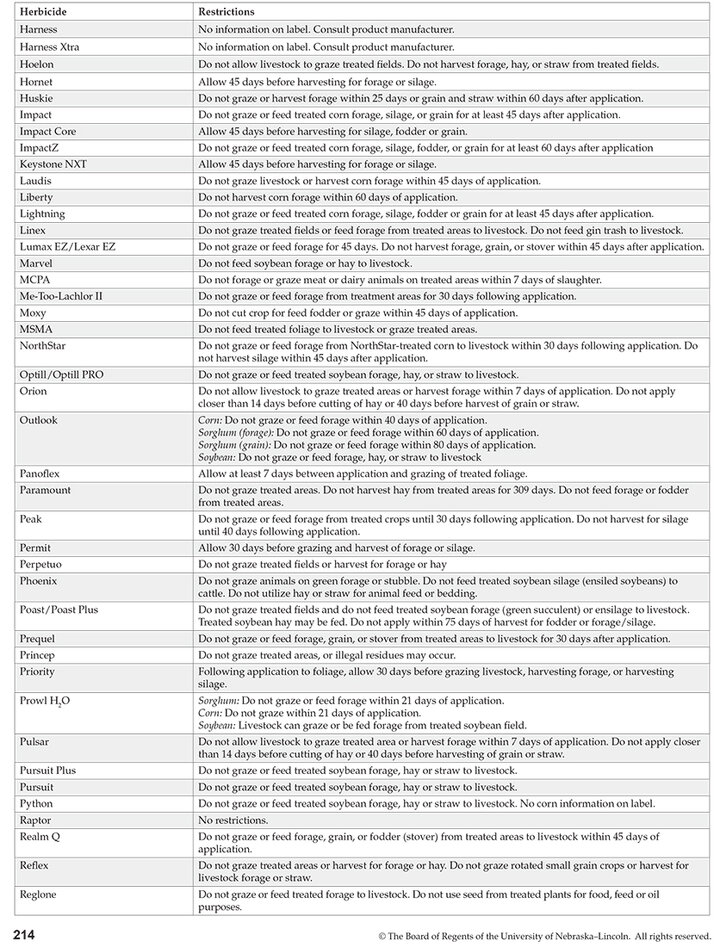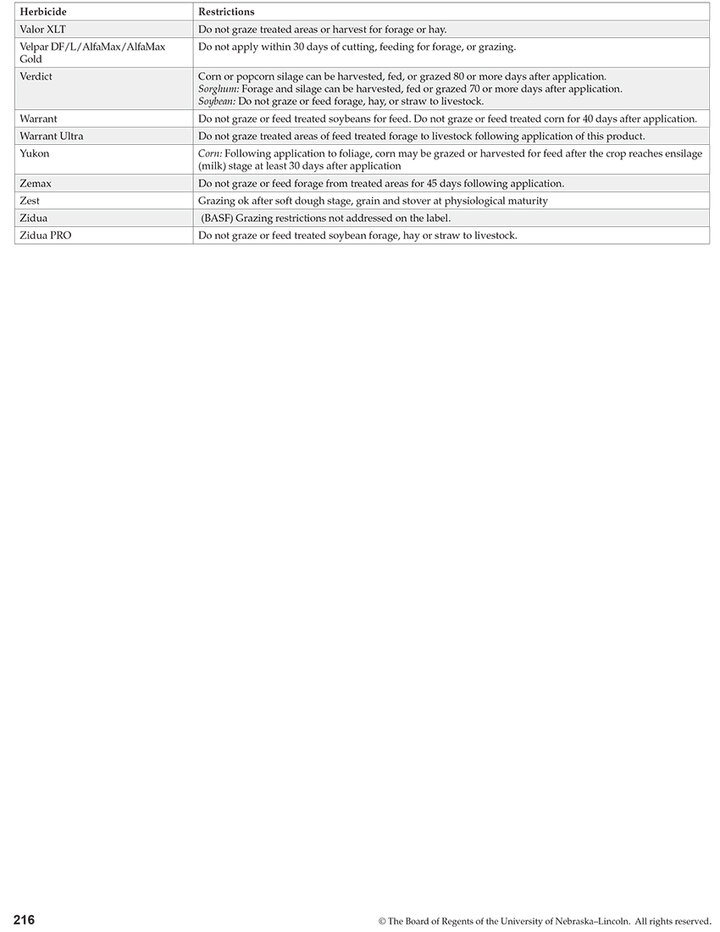We’ve received a number of questions this week on non-irrigated drought-stressed fields and their potential use for forage. For non-irrigated pivot corners, it probably doesn't make a lot of sense to use them for forage unless they're larger areas or forage is needed. Leaving those plants can help with soil erosion too. Corn condition varies throughout the D3 and D4 drought-designated portions of the state, with some corn in the D4 area that is 5-11 leaf and mid-calf to below waist high in height.
Grazing Restrictions: When considering taking drought-stressed corn for forage, first check herbicide labels for any grazing restrictions. Pictures of the forage and feed restrictions from the 2023 Guide for Weed, Disease, and Insect Management can be found at the end of this article.
Crop Insurance: If it’s OK to use the corn for forage, then contact crop insurance. This is an important step as failure to do so can impact the APH assessed to that field for the next 10 years. For corn prior to pollination, stand reduction or permanent wilt loss methods can be used for assessment. The charts will not show much loss for stand reduction. For permanent wilt, the information in the Corn Loss Adjustment Standards Handbook shares about corn plants firing, lower leaves easily crumbling in one’s hands, corn that doesn’t unroll in the evenings and that doesn’t respond to moisture.
Once the crop is released by crop insurance and you’ve waited the period for any restrictions regarding using the corn for forage, the corn can be used for forage. The following are options for consideration.
Grazing: Grazing is one of the better and perhaps more realistic options with as short as this corn is. Yes, there will be nitrates. We aren’t as concerned about grazing corn higher in nitrates prior to ear development compared to if the grazing would occur after an ear was put on. Protein is higher when grazing corn in these vegetative stages. Some keys are to not turn livestock out empty. Providing plenty of fresh water will help reduce nitrate risk. Cattle should self-adapt by eating the tops of plants first and then will be more adapted to eating the higher nitrate areas lower in the plant. While it may be tempting to cross fence and graze as much of the plant as possible (which is what we recommend when grazing corn with ears), in this current situation with no ears, strip grazing will reduce the time animals have to adapt to higher nitrates. Thus, we recommend open access to the field to let animals be more selective and reduce exposure to parts of the plant with potentially toxic nitrate loads.
Some may desire to supplement hay to reduce risk of nitrate poisoning. We’re unsure if it’s necessary and if the cattle would eat it when grazing corn in vegetative stages. The thought is if risk abatement is the idea, then energy would be more beneficial by feeding a little grain. We’re all learning in this so please share what you observe if you try supplementing with grain, hay, or both.
Silage: This really depends on plant height and ability to harvest for silage. Dr. Bruce Anderson shared in a 2012 CropWatch article Using Weather Damaged Corn as Forage that, "Fermentation usually (but not always) reduces nitrate levels and risk. Yield is about one ton per acre of silage for each harvested foot of earless corn plant (not counting the tassel). Feeding value is about 70% to 80% of well-eared corn silage. Corn with some grain (less than 50 bushels) tends to produce about one ton of silage for every five bushels of grain with a feed value about 80 to 90% of regular corn silage. Harvest timing is critical with silage to ensure the correct moisture for proper fermentation. Desired moisture level for silage is about 65%. Plants with any green leaves usually are too wet to chop for silage. For proper moisture, most leaves may need to be dead before chopping. The stalk and ear hold amazingly high water concentrations. For corn with no grain, even if all leaves are dead, the whole plant (and silage) moisture can be 70% if the stalk is still green and alive.
Once plants actually die they can rapidly dry down. There are several ways to reduce moisture content. If corn has pollinated, delay silage harvest until all chances of increased biomass tonnage have passed or plants naturally dry down to appropriate moisture levels. Corn can be windrowed and allowed to partially dry before chopping. Excessively wet material can be blended with drier feeds such as ground hay, cracked grain, or dried distillers grains. However, this can take a lot of material — about 500 lb of grain or hay to reduce each ton of chopped corn with 85% moisture down to 70% moisture. Silage inoculants may improve fermentation and preservation of drought-damaged silage."
Chopping: Chopping is an option to help with reducing nitrates, but really depends on corn height and inability to fence for decisions if one wants to run equipment through it. If feeding green chop, feed immediately after harvest and only feed the amount that the animals will consume in two hours. If green chop is left in the bunk or on the wagon, it can heat up and nitrate will be converted to nitrite. Nitrite is 10 times as toxic as nitrate when fed to animals. Therefore, it is better to feed green chop two to three times a day to ensure that it is cleaned up quickly and not left sitting.
Haying: Haying would be the last option, as it has twice the nitrate risk of grazing. For haying, we’d recommend taking nitrate samples after the hay is baled so you have a better idea on the levels you're dealing with.
Resources: Most of our UNL resources share information on corn for forage once the corn plant has an ear. That's obviously not the case right now. This resource on using drought-stressed corn has additional considerations: Drought-stressed Corn: A Feed Opportunity.
This article under "Management Strategies" is a good resource and fits for grazing young corn: Reducing Nitrate Concerns When Grazing Forage Cover Crops.
Mental wellness and stress management are also important for each of us and to our families. Please check out the resources at Rural Wellness for tips on managing stress. Nebraska Rural Response Hotline: 1-800-464-0258 | Website.
Forage, Feed and Grazing Restrictions for Row Crop Herbicides
Click to enlarge the following images, or download as a pdf here.






